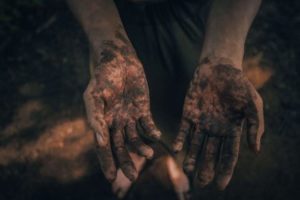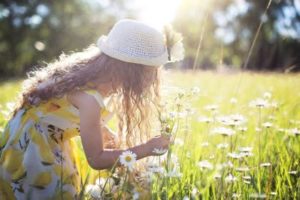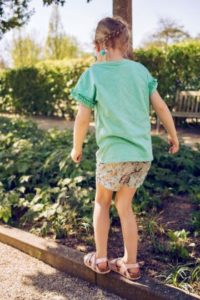Outdoor Learning Activities You Can Do at Home
Here at Wildchild we’re devastated that the corona virus means countless children are missing outdoor learning opportunities and the chance to get into nature. Our award-winning residential school trips are a perfect way to ditch the screens and get outdoors, but we must stay closed until the danger has passed.
That got us thinking about parents facing home schooling for the first time. How can you find outdoor learning opportunities and get into nature when you’re stuck at home?
We’ve compiled nine easy outdoor learning activities you could do in your garden. These ideas are for all ages, from toddlers up to teenagers. You don’t need a massive outside space to have fun with nature.
1: Digging in the Mud
Did you know the harmless bacteria in mud has countless health benefits?
 It can:
It can:
- Stimulate the immune system
- Increase levels of serotonin to sooth and calm
- Help us relax
- Reduce vulnerability to depression
Playing with mud isn’t just for toddlers. Even your older teens can learn from handling and experimenting with soil.
Young Children
Have fun making mud pies, digging and feeling the texture of the mud. Give your child simple tools or improvise with kitchen equipment. Let them explore how the soil feels in their fingers.
Create a mud kitchen and make potions using natural ingredients. All you need is a container and spoon. They can mix mud and water together and try adding leaves, petals and grass to their concoctions.
Older Children
Entertain older children for hours with this easy outdoor learning challenge. Get them to dig, scoop and build up mud to make a narrow track. Challenge them to get a marble to roll down their path or give them a jug and task them to get water to travel down the trail.
There are lots of fun mud experiments that can be done at home without expensive outdoor learning equipment. Try this soil test to find out what the soil in your garden is made from. You only need a jar or an empty soft drink bottle. It can lead to researching different soil types around the country.
2: Make Collections
Children young and old, love making collections of objects. Give them a category, and ask them to find items that fit the criteria.
Ideas for groups of objects they could collect:
- Smooth/ rough/ textured surfaces
- A particular colour
- Straight/ curved edges
- Exactly 10cm long
- Patterned/ spotted/ striped
- Choose their own adjective (describing word) for a new group
Your kids will love taking photos, or drawing the objects they’ve collected. Older children can create photo collages and presentations about their collections.
3: Gardening
 Dig out those old sunflower seeds at the back of your cupboard and get growing. Whilst there’s still a risk of frost, start the seeds in a pot on a sunny windowsill and move them outside when it’s warmer at night.
Dig out those old sunflower seeds at the back of your cupboard and get growing. Whilst there’s still a risk of frost, start the seeds in a pot on a sunny windowsill and move them outside when it’s warmer at night.
Observe how the seedlings grow. Get them drawing, measuring and recording their findings each week. It’s a chance to talk about where our food comes from and what plants need to survive.
Older children could explore growing conditions. Place the pots in different locations to compare how they grow. What happens if one doesn’t have access to light or water?
4: Natural Art
Natural materials are perfect for making sculptures and pictures. Use anything you can find in your outdoor space.
Younger Children
- Use petals and leaves to make natural pictures
- Make faces using different materials
- Build sculptures using sticks and stones
- Create prints of leaves and sticks using paint
- Make leaf rubbings using crayons
- Stick natural materials to make a collage
- Make repeating patterns of leaves, stones, sticks and petals
Older Children
- Research the work of natural artists such as Andy Goldsworthy for inspiration
- Send your child out with a camera to capture nature shots
- Draw and paint natural objects in the garden
- Collect items and arrange them into a ‘still life’ for drawing and painting
- Create a flower press by placing flower petals between two pieces of kitchen roll and press them between the pages of heavy books
5: Observe the Birds
We are lucky to have so many wonderful birds in our country. Even if you don’t have an outdoor area, you can open a window and help your child carefully look out to spot the different types.
Try these simple activities:
- Make a chart of the different birds you spot
- Use the internet to research birds you’ve seen
- Look at how the birds fly through the sky and create your own bird dances
- Make drawings and paintings of birds you see
- Listen to bird song- you could record it on a mobile phone
- Create your own bird inspired music
Leaving out breadcrumbs, seeds, porridge oats, or even grated cheese is an easy way to attract more birds to your home.
6: Cloud Pictures
Lie down outside and watch the clouds go by. Talk about the speed at which they travel and the size and shapes you can see.
Clouds often look like different objects. What can your child spot? Have fun inventing characters and stories using the clouds for inspiration.
Let older children research the three levels of clouds and the names of different cloud types. It’s the perfect start for a outdoor learning geography project on rainfall.
7: Measuring
Give your child a ruler or tape measure to see how tall different plants and garden items are.
Record measurements in a list or bar chart. Can they compare heights? Younger children can use words like ‘shorter than’ and ‘taller than’, older children calculating the numerical difference.
Make rain gauges using an empty bottle and measure the rainfall over a week. This would look great presented as a line graph.
8: Obstacle Courses
 Use anything you have in your outdoor space to create a simple obstacle course. The kids can climb over, go around and crawl underneath to get all their muscles working.
Use anything you have in your outdoor space to create a simple obstacle course. The kids can climb over, go around and crawl underneath to get all their muscles working.
You could:
- Draw chalk shapes to jump in and weave around
- Set up low items to jump over
- Draw a map to follow around your garden
- Include garden toys as a part of the course
- Let your children design a new course for you to follow
If your kids like competition, add in a timer, and run races. See if they can beat their own time to create a personal best.
9: Water Play
When the temperature feels warm enough, fill a bowl or bucket with warm water and add a few empty containers. There’s no need to have special outdoor learning equipment; use items from your kitchen and thoroughly wash them at the end of play time.
Try these ideas for young children:
- Add in bath toys or plastic figures for small world play
- Use bubble bath or washing up liquid for foamy fun
- Explore which items float and sink
Older children can estimate and measure the capacity of different containers using a measuring jug.
Final Thoughts
With schools closed, parents face extraordinary challenges. These are difficult times for many families.
You might be struggling to:
- Juggle a full-time job and look after children
- Know what you should be teaching your kids
- Entertain small children stuck at home
- Keep everyone healthy with limited exercise options
Outdoor learning is a fantastic way to cover tonnes of the school curriculum in many subject areas. If you want to find out more about teaching using nature, check out the Muddy Puddle Teacher for a fantastic range of outdoor learning activities that combine fun, learning and the great outdoors.
Schools are trying desperately to provide work for you to do at home. Many have sent packs for you to do. But remember, learning doesn’t need to happen sitting at a desk. Lots of the tasks you are given can be taken outside.
We hope that the restrictions of corona virus will pass as soon as possible. But in the meantime, using outdoor learning is a fantastic way to reduce the stresses of being stuck at home for weeks on end. And when it’s all over, we can’t wait to welcome you back.
Wildchild connects children to the outdoors with wonderful residential school trips. Every Wildchild trip has a simple aim: to connect all children with the great outdoors, inspiring them to learn new skills and discover inner talents, whilst having the time of their lives.
Recent Posts
- Why you should be insisting on LOtC for your school residential trips
- The impact of Nature deficit disorder and the preventative role schools can play
- Residential trips for secondary schools to ease transition
- Building character through primary school trips
- Six reasons why more schools are choosing UK school trips (spoiler alert: it’s not because of Covid!)
- School trips after the pandemic
- 5 winter outdoor learning activities for schools
- 5 ways to get more from your School Bushcraft Trip
- Residential trips to benefit learning
- Perfect Primary School Trip Planning
Blog home






